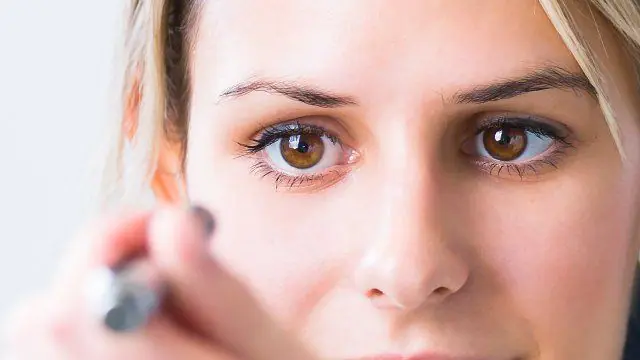
Causes and symptoms of ocular nystagmus. Diagnosis, medicinal, conservative and surgical treatment of eye tremor. Prevention measures.
The content of the article:- Reasons for appearance
- Symptoms of eye nystagmus
- Diagnostic methods
- Treatment options
- Medicines
- Optical means
- Surgical intervention
- Prevention
Nystagmus is an ophthalmic pathology in which the eyeballs make uncontrolled oscillatory movements. Such tremor is not an independent disease. It acts as a symptom or complication of other diseases and is often accompanied by strabismus, refractive error (refraction of light rays), and deterioration of visual acuity.
Causes of eye nystagmus

Normally, eye tremor occurs when exposed to an optical or vestibular stimulus. Thus, the cause of nystagmus is observation of a rapidly moving object (train, carousel). The same reaction is characteristic of stabilizing the body after rapid rotation. A distinctive feature of physiological nystagmus is the rapid normalization of vision.
Eyelid tremor is often observed in children of the first year of life. This state of the visual system is associated with underdevelopment of the central nervous system, unformed visual organs, and weakness of the vestibular apparatus. Normally, infantile nystagmus disappears on its own after a few weeks. If the pathology persists after six months, you should contact your pediatrician.
Causes of pathological nystagmus:
- Hereditary diseases. Eye tremors can be a symptom of a serious illness passed on from parents. For example, albinism is characterized by a lack of pigment on the skin and hair, and underdevelopment of visual function. Severe myopia (below 5 diopters) is also manifested by involuntary trembling of the eyeballs.
- Birth injuries. During a difficult pathological birth, the child’s head is often damaged: the skull is compressed, the facial nerve is pinched, and internal hemorrhage occurs. All these complications are manifested by eye tremor, which does not go away as the baby grows. Involuntary shuddering of the eyeballs also appears after a newborn passes through an infected birth canal.
- CNS diseases. Diseases of the central nervous system are the most common cause of eye tremor. These include multiple sclerosis, encephalitis, inflammation of the lining of the brain and spinal cord. In addition to nystagmus, these pathologies are manifested by headache, numbness of the fingers, muscle paresis, weakness, and impaired coordination of movements.
- Lesions of the inner ear. Eye nystagmus appears with inflammation, perforation, purulent otitis media. The symptom is characteristic of Meniere's disease, in which the volume of fluid in the labyrinth increases. This type of disease in children can be suspected by prolonged crying, which intensifies with pressure on the tragus of the ear.
An overdose of drugs for the treatment of epilepsy, insomnia, and mental disorders can also be manifested by tremor of the eyeball. In this case, you need to consult a doctor to adjust the treatment regimen.
Symptoms of eye nystagmus
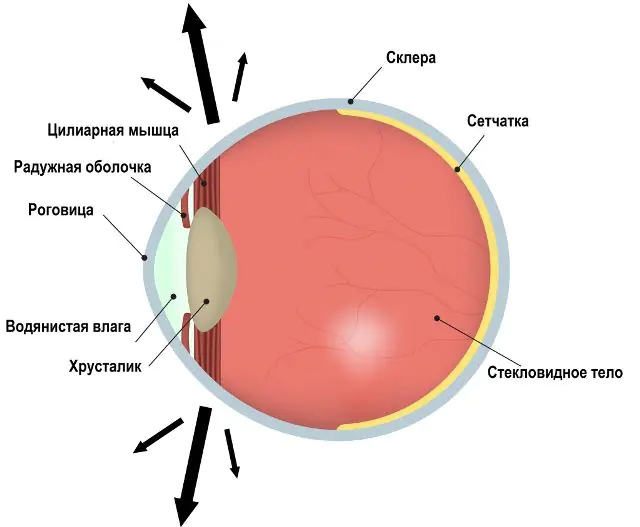
Mechanism of development of nystagmus
Congenital nystagmus of the eyeball can be noticed even in the maternity hospital. The pediatrician registers the child if the tremor does not go away after 2-3 months of life. The acquired form appears along with the development of the underlying disease. The patient complains of tremors of the eyeballs, inability to focus on an object, and difficulties with orientation in space.
The patient tries to stop the movement of the pupils. To do this, he turns and tilts his head, squints his eyes, and covers one of them with his hand. In addition, a person suffers from photophobia, dizziness, pain in the temples, and vomiting. To these manifestations of nystagmus are added the symptoms of the underlying disease.
Please note that involuntary eye tremor increases in stressful situations, with excitement and fatigue. The severity of symptoms increases during the acute phase of the underlying disease, as well as with a combination of several irritating factors.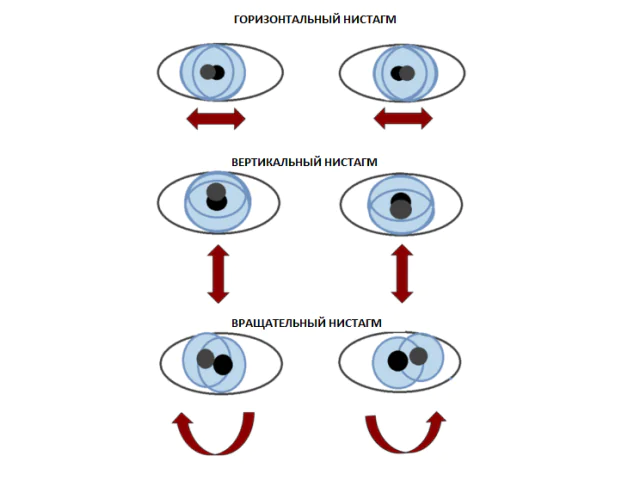
Based on the direction of oculomotor movements, nystagmus is divided into the following types:
- vertical (the pupils move up and down synchronously);
- horizontal (the pupils move synchronously left and right);
- diagonal (the pupils move from the temples to the bridge of the nose);
- dissonant (chaotic movement of the pupils);
- monocular (oscillatory movements are performed by only one pupil).
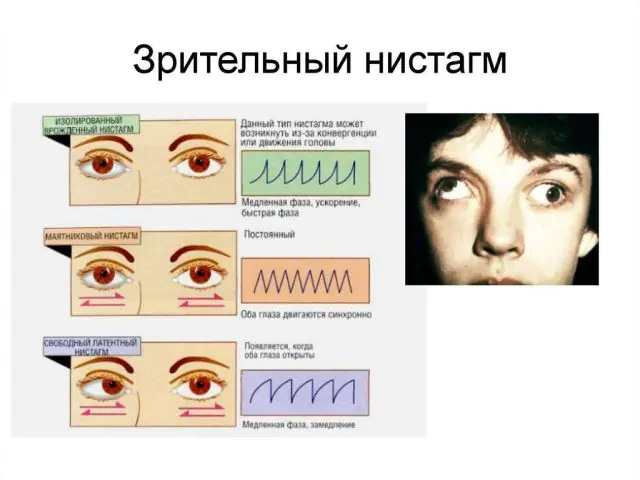
Types of eye nystagmus
Based on the intensity of the vibration, nystagmus is divided into jerky, pendulum and mixed types.
Without treatment, nystagmus is complicated by the following pathologies:
- Torticollis. To better examine objects and navigate in space, a sick person constantly changes the tilt of his neck. Because of this, the upper spine, neck muscles and nerves suffer. As a result, compensatory torticollis develops, the treatment of which is impossible without first eliminating the underlying disease.
- Strabismus. A person with ocular nystagmus tries to stop the pupils from oscillating on their own. To do this, he tenses the muscles and ligaments of the eye. Overload of these fibers sometimes leads to deviation of the visual axes to the temples, asymmetrical location of the iris in relation to the bridge of the nose.
Methods for diagnosing eye tremor
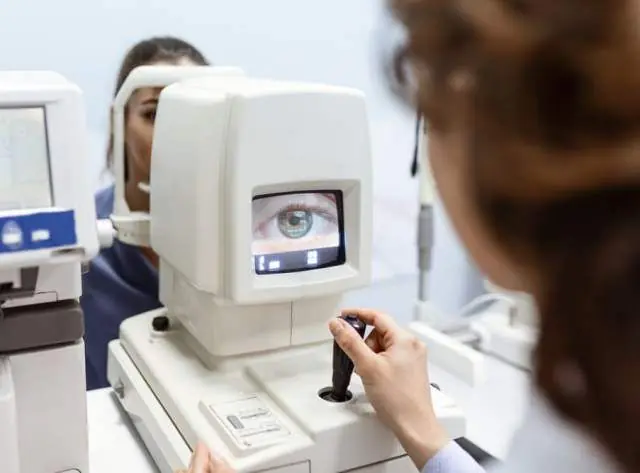
When the first symptoms of pupillary tremor appear, you should consult an ophthalmologist. The doctor examines the medical history, asks about all cases of illness, signs of visual impairment, hearing, coordination, and mental health.
Next, he brings the pen to a distance of 30 cm from the patient’s eyes, asks him to fix his gaze on it, follow its movement up, down, left, right. It is important for the doctor to identify the moment at which the pupils begin to spontaneously shudder. Such a study helps to identify the root cause of the pathology.
Further examination is carried out according to the following scheme:
- Determination of visual acuity. The patient sits on a chair that is located 5 meters from the table. It shows letters of different sizes. The patient must name those that the doctor points to. Each eye is examined separately, with or without glasses.
- Examination of parts of the eye. The examination is carried out using a slit lamp. It is a device equipped with a magnifying glass and a lighting element. Before the examination, the patient is given a drop of a drug to relax the ciliary muscle and enlarge the pupil.
- Laboratory diagnostics. To identify the root cause of ocular nystagmus, the patient donates blood and urine for analysis. The results of the study are assessed not only by an ophthalmologist, but also by a neurologist, otolaryngologist, therapist or pediatrician.
- Vascular angiography. The procedure is performed under local anesthesia. The patient is positioned in front of the X-ray machine. The doctor inserts a catheter into the vein and advances it to the desired vessel. Then a contrast agent is injected and a series of x-rays are taken.
- Electroencephalography of the brain. The study is carried out in a soundproofed room without natural light sources. A “cap” with 21 electrodes is placed on the patient’s head. The computer records brain signals from clenching a fist, deep breathing, loud sounds, and blinking LEDs.
- MRI of the eye orbits. The patient lies with his back on the couch, which slides inside the tomograph. For 20 minutes, a device rotates around the head and takes layer-by-layer images. The results are displayed on a computer monitor and transmitted as an image to the doctor.
At the next consultation, the ophthalmologist explains how to treat nystagmus and refers the patient to other doctors to draw up a treatment regimen for the root cause of the pathology.
Methods for treating ocular nystagmus
Eye tremor disappears after treatment of the underlying disease. To quickly normalize vision, doctors recommend taking eye vitamins, choosing optical aids, and performing ophthalmic exercises. In severe cases, the patient requires myoplastic surgery.
Medications for eye nystagmus

Cavinton for the treatment of eye tremors
Drugs with a vasodilating effect improve the nutrition of eye tissue. And vitamins saturate the organs of vision with useful substances and strengthen local immunity.
The most effective drugs for treating ocular nystagmus include:
- Cavinton. The medicine is prescribed to stimulate cerebral circulation. After taking it, the blood vessels dilate, blood flow accelerates, due to which the brain receives more oxygen, nutrients and medicinal substances. The drug is prepared in the form of tablets and liquid for intravenous injection. Price - from 160 rubles in Russia (65 hryvnia in Ukraine) for 30 tablets.
- Trental. The drug reduces blood viscosity, has a vasodilating effect, improves nutrition of the brain, organs of vision, and hearing. Prescribed only to adult patients. Treatment is carried out under blood pressure control. Price - from 550 rubles in Russia (215 hryvnia in Ukraine) for 5 ampoules.
- Vitrum Vision. The drug contains vitamins, minerals, microelements. It is prescribed for eye restoration after severe treatment and increased stress. The components increase visual acuity and protect eye tissue from external and internal irritants. Price - from 600 rubles in Russia (250 hryvnia in Ukraine) for 30 tablets.
Optical treatments for eye tremor
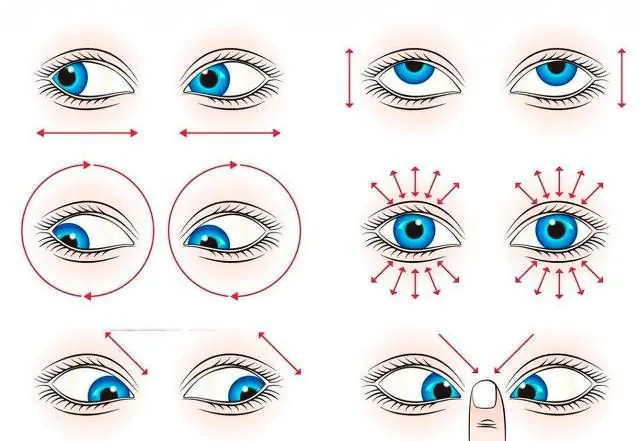
Ophthalmic gymnastics for eye nystagmus
Eye tremor is often accompanied by refractive error (the refraction of light rays). Glasses and contact lenses help the patient see better, that is, less strain on the ciliary muscles. Therefore, wearing optical instruments is an essential part of the treatment of nystagmus accompanied by myopia, farsightedness or astigmatism.
Eye tremor is a common symptom of albinism (a disorder of pigment metabolism in the body). People with this disease are very sensitive to sunlight. Therefore, their glasses for vision correction are always darkened and equipped with special filters.
A weak degree of nystagmus is corrected with the help of ophthalmic gymnastics. Exercises train the eye muscles and prevent complications of the disease.
How to perform gymnastics for eye nystagmus:
- Lightly press your palms onto your closed eyelids.
- “Draw” and “write” with your eyes closed.
- Look alternately at the glass of the window and at distant objects on the street.
- Follow the finger of the moving hand.
- Look at objects from the side without turning your head.
Computer stimulation of the visual organ is used to treat nystagmus in children. The exercises are designed in the form of games (“Cross”, “Spider”, “Zebra”).
Surgery for the treatment of eye tremor
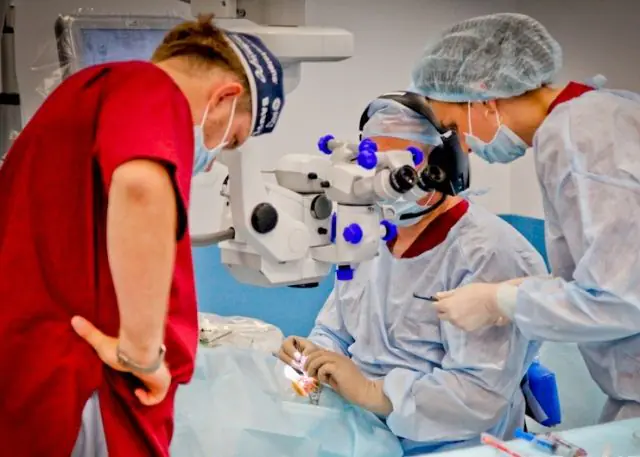
If nystagmus does not respond to conservative treatment, surgery is prescribed. It is performed on both eyes under general anesthesia. Contraindications: age under 3 years, pregnancy, acute phase of the underlying disease.
During surgery to eliminate nystagmus, the surgeon weakens the strong extraocular muscles and strengthens the weak ones. As a result, the tremor disappears. In severe cases, the amplitude of oscillations of the eyeballs decreases. In addition, strabismus is corrected and visual acuity improves.
Postoperative recovery lasts 3-5 days. During this period, you should not strain your eyes, play sports, or be outside during strong winds, rain, or frost. It is recommended to take vitamins for the eyes and general strengthening of the body.
Prevention of eye tremor
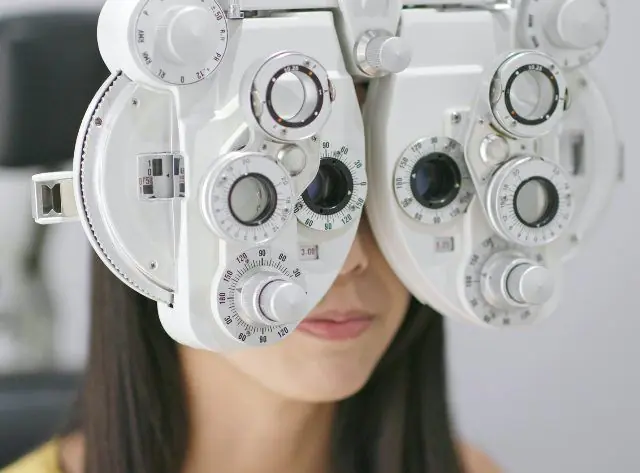
Nystagmus is often a complication of many diseases. Therefore, to prevent it, do not ignore the early symptoms of diseases, do not skip preventive examinations, and do not refuse additional diagnostic procedures.
Follow the rules of ear hygiene, clean only the outer shell, and do not insert a cotton swab deep into the ear canal. Wear a hat in frosty, windy weather, and get rid of fluid in your ears after swimming.
Strengthen your health with the help of hardening procedures: contrast showers, swimming in ponds, relaxing in environmentally friendly places. Follow the principles of a healthy diet, play sports, and give up bad habits.
What is eye tremor - watch the video:



